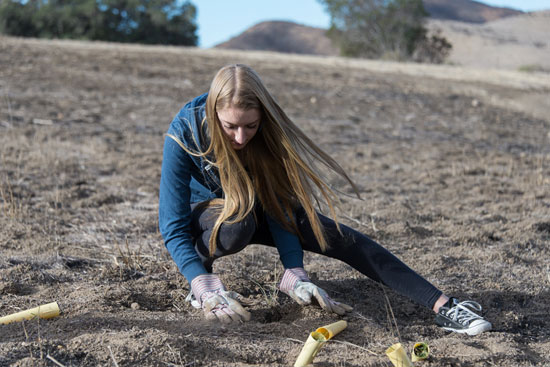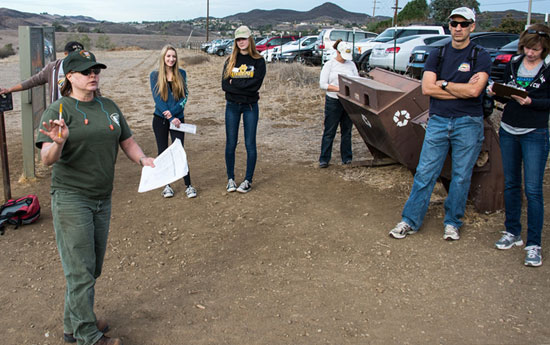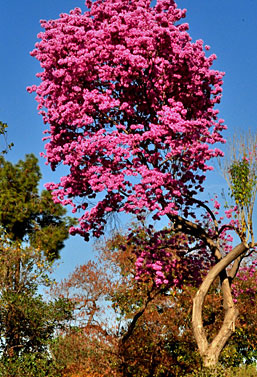Drought reigns in plant kingdom
February 6, 2014

A volunteer helps plant one of 24,000 seedlings that have languished in a nursery because of drought conditions on hillsides charred by last year's massive Springs Fire. Photo/Steve Friedman
Last spring, after Sycamore Canyon was devastated by the earliest fire season in memory, Irina Irvine raced to protect the scenic landmark from an ancillary threat.
A restoration ecologist with the National Park Service, Irvine had been working to rid the Santa Monica Mountains National Recreation Area of destructive non-native grasses. Some of her most successful work had been in the hills around Newbury Park, where, in May, the fire had started.
Knowing that opportunistic plants could retake and wreck the natural ecosystem if she didn’t act quickly, Irvine prepared 24,000 native seedlings—elderberry and oak, coastal sage and purple needle grasses. Then she waited for the winter rains, when the sprouts could be planted.
And waited. And waited.
“Twenty-four thousand plants at $3 a plant, and several interns hired especially for this,” says Irvine. “And it hasn’t rained yet.”
Lawns aren’t the only landscapes that are starting to feel the effects of this year’s extreme drought. From street medians to coastal canyons, local naturalists say the shortage of water is having all sorts of unprecedented impacts.
At the Los Angeles County Arboretum and Botanic Garden, the absence of soil-cooling rain has tricked spring-blooming trees into blossoming as if it were April. In the San Fernando Valley, meanwhile, wildflowers are failing to germinate for lack of water.
In the Angeles National Forest, the drought has not only dried up natural springs but also emptied rain-catching “guzzlers”, small man-made reservoirs that provided a reliable fallback in past years for thirsty birds and wildlife. In the Santa Monica Mountains, the extreme water shortage has made historic oaks vulnerable to bark beetles and weakened even resilient trees such as eucalyptus.
“There’s been a lot of die-off in the native vegetation,” says Florence Nishida, a resident of Topanga Canyon and master gardener at the Museum of Natural History. “Landscaping at least has some source of water. But in the natural areas, the plants have gone since last March or April until now with hardly a drop of rain.”
Frank McDonough, botanical information consultant at the Arboretum, says the region is feeling a triple whammy—a years-long drought combined with a warmer-than-usual fall and winter and a high-pressure ridge that has cut off California’s usual dose of rain. Without a series of good, soaking downpours to cool down the soil, he says, the tree roots don’t realize it’s winter, and that, plus last month’s record heat, has left plants confused.
“Now our pink trumpet trees, which usually don’t bloom until March, are covered in blossoms, and the flowering apricots and nectarines are starting to bloom,” says McDonough, adding that more than a year or two of such unusual conditions can weaken trees and leave them vulnerable to disease and insects. Although it’s not necessarily good news, he says, “I expect the cherries will bloom earlier than normal, too.”
In wildflower country, on the other hand, the lack of rain is just depressing.
“It’s been pretty pitiful for the past two years, and it will probably be the same or worse this year,” says Lili Singer, director of special projects and adult education at the Theodore Payne Foundation, a Sun Valley nonprofit that operates an annual wildflower hotline.
For a good show, she says, wildflowers need at least one serious rain per month, starting in the autumn, so that they can establish themselves and produce plenty of buds before they start flowering. But with the exception of man-made seed-sowing initiatives such as Wildflowering L.A.—whose gardeners have been forced to water their supposedly drought-tolerant seedlings far more than expected—and the possibility that a few rare species will sprout in the wake of recent brush fires, Singer and other naturalists say they don’t have high hopes for this season.
“There’ll always be something for people to see,” says Singer, “but it will be a lot lower in the number of plants and the diversity.”
Nor are the wildflowers the only living things that are thirsty. In the Angeles National Forest, for instance, the county this week approved a grant to repair watering stations for wildlife and birds.
“This drought has just been real tough,” says John Forgy of the San Gabriel Valley chapter of Quail Forever, an organization that has offered to make the repairs as part of its work supporting wildlife. “And some of the young birds only eat insects, and there are no insects if there’s no rain.”
Irvine of the National Park Service says she has seen all these drought symptoms and more in the Santa Monica Mountains, where, in the plant world at least, “everything’s a little wacky right now.”
Vegetation, she notes, is vital in wildlands, not only because it’s habitat for wildlife, but also because it prevents erosion and counteracts global warming by sequestering carbon dioxide.
In areas like the mountains, where many species have evolved around drought, a dry year or two isn’t necessarily alarming.
“But you can only push so far before you reach a tipping point,” says Irvine. “When I see a big eucalyptus that’s been here for 50 years dying because there’s no water, that catches my attention. Pine trees are being hammered. And we are already seeing significant die-back in chaparral communities, and we don’t know if they’ll pop back up again if it rains, or if, when it’s gone, it’s gone.”
Particularly unnerving has been the effort to restore those 10 acres near the Wendy Trail head near Newbury Park at Rancho Sierra Vista in an area that was consumed last May during the freakishly early Springs Fire. Fueled by Santa Ana winds that had sucked the humidity in the air down to the single digits, the blaze swept from the canyons to the surf, consuming some 24,000 acres of drought-dried Los Angeles and Ventura Counties.
Among the casualties were some of the most scenic spots in the Santa Monica Mountains, including acreage on which Irvine had spent months trying to eradicate a particularly toxic and invasive strain of Australian bunch grass. The plan was to replant the area as quickly as possible with native seedlings that Irvine had carefully sprouted and set aside in a nursery.
“Normally what one does is wait for the first soaking rain of the year and then run, quick like a bunny, to get the plants in the ground as soon as the soil softens,” says Irvine. She had banked on an autumn planting. “But then when it didn’t rain in October, we were, like, ‘Darn it’,” she says. “And then no rain again in November. Darn it. And then December. And it was, ‘Are you kidding me?’”
The longer they waited, she says, the harder the earth got, making it even more difficult to transplant the seedlings that were in the nursery. And letting 24,000 seedlings die at $3 per seedling was not in the plan.
So when January came with no rain, she says, “We just said, ‘That’s it—we’re planting.’” Since January 17, Irvine says, she and a crew of interns and volunteers have been struggling to get the groundcover into the earth, which is so hard and dry that they’ve had to drill holes for the plants with a motorized augur.
“That’s 24,000 holes,” she says. “It’s been very slow going. We’ve only gotten about 9,500 plants into the ground, and we’ve been out there every day but Sunday and Martin Luther King Day.” Most recently, she says, she set aside $10,000 so she could water the plantings if necessary with a fire hose and a water tanker.
“If it rains substantially, of course, all bets are off,” Irvine says. “But from what I understand, just to get back to normal we’d have to have a couple of inches a day from now until about May.”

"You can only push so far before you reach a tipping point,” Irina Irvine says of the drought. Seen here in green, she gets the troops ready for planting seedlngs in the hard dirt. Photo/Steve Friedman
Posted 2/6/14













 405 bridge work causes a stink
405 bridge work causes a stink
